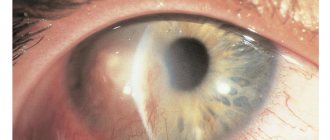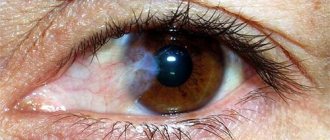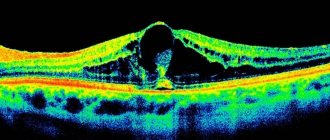Reason 1: Computer time
Everything is simple here, because everyone knows that you need to take breaks when working at the computer.
Take a break from the screen for 10-15 minutes every hour. It would be great if you did some simple eye exercises during these 10-15 minutes, your eyes will thank you =)
By the way, you can safely relax at work, too, because... These rules are also enshrined in legislation (you can find the Standard Instructions for Occupational Safety and Health when working on a personal computer TOI R-45-084-01 and the corresponding SanPiNs).
Take a break from the computer every hour
There are many programs that will remind you that it’s time to relax; if you want to know more about them, write in the comments.
Early Actions
Many people start thinking about how to wake up at work if they close their eyes while still at home. This happens - a person has just gotten up, but has already realized that the day will be sluggish. This is even better because there is time to fix everything.
Naturally, you need to drink a cup of coffee. Not soluble, but ground, strong. Preferably without sugar and definitely without cream. Strong green or black tea with a high tannin content can also have the desired effect. By the way, citrus juice will invigorate you even better. It's also worth eating dark chocolate. The main thing is not to overload yourself with breakfast, because the feeling of fullness usually leads to a desire to sleep.
And, of course, you should definitely take a contrast shower. Unfortunately, it is rare that any workplace is equipped with a shower, so you could treat yourself to this tonic procedure at lunchtime. But no one canceled washing with cold water.
It is advisable, if you have time, to do exercises before going to the shower. Squats, push-ups, presses - just one approach at a time. This will help you warm up and warm up your body. After such a set of procedures, a person will come to work in a cheerful spirit.
Symptoms of eye fatigue
Eye fatigue manifests itself in the form of a complex of symptoms, but not all of them will necessarily be noticeable. A combination of even several of these signs can indicate fatigue:
- pain in the eyes and head;
- feeling of the presence of “sand” or a foreign body in the eyes;
- dry eyes or vice versa – profuse and poorly controlled tear production;
- decreased visual acuity;
- general fatigue , which occurs faster than usual;
- bruises and dark circles under the eyes;
- dilation of blood vessels on the surface of the mucous membrane of the eye and its redness;
- visible images may appear double or distorted;
- floaters, dots and fog appear before the eyes;
- there is a burning sensation and heaviness in the eyes ;
- turning the eyes without turning the head is difficult or impossible;
- arterial and intraocular pressure may increase;
- heaviness appears in the eye area , the eyelids involuntarily close.
If at least two or three of these signs are detected, you should contact an ophthalmologist, since prolonged eye fatigue can lead to the development of more serious pathologies.
Why does it put pressure on the eye?
In a situation where the eyes hurt as if they were pressing, it is necessary to study the regularity of this manifestation and the circumstances of its occurrence. For isolated attacks in people working at a computer or with papers, there is no need to worry too much. It is necessary to contact a specialist if the patient develops additional symptoms. A condition when there is constant pressure on the eyes is considered a dangerous signal, so this most often indicates various diseases.
Migraine
With a pathology such as migraine, pain localizes to one side of the head. In addition, there is a pulsation in the temple, which spreads to the ear and organs of vision. If your eyes are closed, colored circles are formed, which are complemented by flashes. In addition, there is pronounced pulsation in the eyelid area.
A migraine attack can last from several hours to 2-3 days, and during this period the patient becomes too irritable. In addition, there is a feeling of weakness and constant fatigue. With loud noise and bright light, there is an increase in pain.
Overwork
Working at a computer for too long and reading small print texts increases the likelihood of eye discomfort. In addition, the cause of severe pain can be any activity that requires increased attention and strong visual strain.
With severe overwork, a person suffers from pain in the organ of vision, a sensation of cutting and burning. It feels as if sand has been poured into the eyes, and there is a disturbing feeling of pressure and heaviness.
Glaucoma
A pathology such as glaucoma, caused by an increase in pressure inside the organ of vision, does not always provoke pain. Usually there is a dull or aching pain, which is complemented by various visual changes. Fogging of the cornea, the appearance of rainbow circles and photophobia are observed.
During an acute attack of glaucoma, the patient experiences sudden pain in the organ of vision, which radiates to the temples, the back of the head and sometimes along the trigeminal nerve. Attacks of nausea and dizziness, as well as significant changes in the eyes, may occur. When examining the patient's face, it becomes noticeable that the cornea and eyelids swell greatly, and the pupil dilates significantly.
With glaucoma, the patient may experience severe discomfort. It should be remembered that pain cannot be relieved with painkillers. Only drugs that lower blood pressure help alleviate the patient’s condition.
Increase in pressure
The situation with pain from inside the eyes may indicate surges in intracranial pressure. The cause of the pathological condition lies in a concussion, stroke and impaired outflow of cerebrospinal fluid. In addition, a rapid increase in the size of a cyst or malignant neoplasm localized in the skull can cause pain.
The patient complains not only of pressure, but also of increasing pain, pain and pulsation behind the organ of vision. When coughing, blowing your nose and other sudden movements, an even greater increase in pain is noted. In addition, symptoms such as nausea, spots before the eyes, hallucinations and increased drowsiness may appear.
In some cases, pressure from inside the eyelids and the appearance of a feeling of fullness inside the organ of vision indicate surges in intraocular pressure. The patient experiences severe redness of the sclera and a feeling of heaviness in the eyelids.
If the increase in pressure inside the eyes is chronic, then there is a high probability of degeneration of the optic nerve and the appearance of glaucoma. With this pathological condition, the patient experiences a gradual narrowing of the field of vision and, in the worst case scenario, the patient may become completely blind.
Other reasons
Experts identify some reasons that cause increased pressure in the eye and pain:
- Increased psycho-emotional stress. In this condition, any increased stress can cause severe pain in the forehead and eyes.
- Osteochondrosis of the neck. The cause of damage to the organ of vision is frequent headaches and curvature of the spine.
- Various visual impairments. Various infections inside the organ of vision, inflammatory processes, barley and injuries to the corneal layer of the eye can provoke an unpleasant symptom.
- Problems with blood supply to the brain. This condition causes headaches, which can result in a stroke.
- Injuries and damage to the skull. Pressure in the eye in this pathological condition can be accompanied by weakness, nausea, double vision, and a constant desire to sleep.
- Changes in hormone levels in the female body. Most often, expectant mothers experience a feeling of pressure in the eye during pregnancy.
In addition, pain and increased pressure in the eye can be observed with diabetes, a decrease in the body's defenses and bad habits. An unpleasant symptom often occurs when the body is poisoned, has allergic reactions, or wears glasses that were chosen independently without consulting a doctor.
Reason 2: Incorrect workplace lighting
There should be no glare on the screen from light sources (do not work with your back to the window, watch the location of the lighting lamps). The room should not be too dark (do not work in absolute darkness).
- Avoid screen glare
- Don't work with your back to the window
- Remember to leave some background light at night.
Monitor the lighting in the room, do not work in complete darkness
It is optimal to place the monitor and desktop sideways to the window , in this case you will reduce the problem with glare to a minimum.
Changing brightness and contrast
These parameters are not the same for all monitors; this primarily depends on the technology on which it is built (matrix), as well as room lighting.
How to change the brightness and contrast of the monitor?
Again, go to the parameters of your video card, as I showed just above, and go to the “Display” . On the left, go to the “Color Settings” and begin to configure the monitor to suit your needs. I won’t advise you anything here, I’ve already said what determines brightness and contrast.
Brightness settings from Control Panel
You can go to the control panel and do the necessary through the “Power Options” section. You can also get there by right-clicking on the battery icon on the taskbar and going to the “Screen brightness settings” or “Power options” section.
Then, on the desired power plan, go to “Power scheme settings” .
There we move the brightness sliders to the optimal option for you.
By the way, as standard, the screen brightness is adjusted using special keys on the keyboard. There, a button in the range from F1 to F12 is indicated by a special icon.
Reason 3: Too much brightness
The eyes get very tired if the monitor settings are set to too high a brightness level.
Do not work with the monitor at maximum brightness
The brightness level should be adjusted according to the ambient light (be sure to consider how bright the light is in the room you are working in).
To correctly adjust the brightness of your monitor, follow the instructions:
- Set the brightness to minimum;
- Take a break from the monitor for 5 minutes to allow your eyes to adapt;
- Increase the brightness in small steps (10-20%) with pauses of 5 seconds;
- Remember the brightness levels at which it is easiest for your eyes to perceive information on the screen and continue to raise the brightness to maximum;
- Return to the brightness level you find most comfortable.
Treatment
Drug treatment
Treatment with drugs is carried out after consultation with the attending physician. It is prohibited to use any medicine without the doctor’s knowledge; you can buy the wrong medicine and harm your eyes.
Therapy depends on the etiology of heaviness in the eyes:
- For glaucoma, drops are used that reduce blood pressure. In severe situations, the pathology is treated surgically.
- Dry eye syndrome is treated with moisturizing drops. Vitamin complexes, good nutrition and eyelid massage will help restore natural tear production.
- If the cause is refractive error, glasses or contact lenses are prescribed. In this case, myopia, farsightedness and astigmatism are treated with moisturizing and vasoconstrictor drops.
- Viral or bacterial diseases are treated with antimicrobial drops that kill viral agents.
If your eyes are heavy, it is important to take care of their hygiene, write and read at a comfortable distance, and do not look closely at TV or the computer.
Traditional methods
Traditional methods are used both in the fight against diseases and heaviness in the eyes. They can be used if the disease is non-infectious.
Home methods include potatoes, apples, cucumbers, carrots and any other hard vegetable or fruit. Keep it in the refrigerator or place it in the freezer for a couple of minutes, cut off a circle and apply it to your eyelids. Do not hold it for a long time to avoid hypothermia. Two minutes is enough to get a boost of energy and relieve swelling.
Compresses are useful. Gauze or a cotton pad is moistened in the medicinal infusion and applied to the eyes for 15 minutes. Decoctions are prepared from parsley, chamomile, string, and linden. Cool milk will also work.
Gymnastics for the eyes
The exercises are suitable for all patients experiencing this symptom. They will be especially useful for people who work for a long time at a PC or with papers. Gymnastics can be done as desired and can be done up to 3 times a day. Perform each exercise in 1 approach, do up to 9 repetitions.
Effective gymnastics if the eyes close on their own:
- Blink quickly and easily for 2 minutes. This exercise improves blood circulation.
- Imagine a pencil on the tip of your nose. Draw the alphabet and numbers for them. Perform slow movements.
- Open your eyes, blink quickly 10 times. Close your eyelids, relax for 20 seconds, listening to your breathing.
- Place your finger in front of your nose, gently turn your head to the side, peering past the finger. It is necessary to achieve the effect of moving fingers while being completely motionless. Not everyone succeeds the first time; it takes practice.
- Look to the left, inhale and hold the muscles in this position. Count to 3, exhale, look straight.
- Place your finger to your nose and focus your gaze on it. Slowly extend your hand forward, without taking your eyes off your finger.
Gymnastics strengthens the eye muscles. If done regularly within a month, you will stop getting tired quickly.
Reason 4: Monitor backlight flickering
If you reduced the brightness according to the previous tip, be sure to check if your monitor is flickering!
Most modern displays flicker and this flickering usually appears when the brightness is lowered . This also applies to smartphones and tablets.
Animation showing PWM operation
Manufacturers prefer to remain silent about the presence of flicker, and PC users do not understand why their eyes hurt on one monitor and not on another.
Be sure to check if your monitor flickers when you lower the brightness.
To learn about what PWM is and how to check the displays of all your devices, read the article “ What is PWM in monitors and how to protect your eyes? "
Universal methods
There are a huge number of different types of activities. And positions - accordingly. Some people have more freedom at work, for example, office programmers. They can get up, stretch, pour themselves some coffee - in general, get the blood flowing. And there are teachers who, due to the specifics of their work, must give a lecture for an hour and a half. They only have the opportunity to cheer up during a short break. What to do then, how to wake up at work if your eyes are closed?
Fortunately, there are universal methods. You can do a self-massage of your palms. The fact is that on their inner sides there are a lot of active points. With quick and confident pressure from the thumbs, you need to influence them, as a result of which the person will feel a surge of energy. There are many more active points on the ears - on the earlobes and shells. 1-2 minutes of invigorating massage will help you cheer up.
It is also not recommended to remain motionless. Movement helps you stay toned. Gesticulation, walking around the room, stepping from foot to foot - all this prevents the body from falling asleep.
Prevention
Many diseases of the ocular apparatus cause complications and significantly impair vision. If attacks of pressing pain are constantly repeated even in the morning, then it’s time to reconsider your lifestyle and take the necessary preventive measures.
These include:
- regular preventive examinations;
- giving up bad habits (alcohol, smoking);
- proper rest and healthy sleep for 8 hours;
- following a planned daily routine;
- complete, balanced nutrition;
- performing therapeutic (preventive) massage.
If you notice any disturbances in the functioning of your visual organs, do not delay your visit to an ophthalmologist or ophthalmologist .
Lighting
Well, the last point in this article is room lighting, here’s what we can recommend in this case:
- Direct sunlight and other artificial light (lanterns, spotlights, etc.) should not fall on the monitor screen. Because of this, the picture is hard to see, and you begin to strain your eyes to see something;
- Do not work at the computer in complete darkness; have at least a light on next to you;
- Wipe the screen against dirt and dust during use.
Well, that seems to be all, these are the basic parameters that you can configure on your computer monitor so that your eyes don’t get tired. If you also have something to offer, then tell us about it in the comments.
You've probably noticed that the monitor can make your eyes tired or even hurt. At the same time, you may have noticed that on different monitors your eyes can get tired in different ways (this applies not only to desktop PCs and laptops, but also to smartphones and tablets).
Today we will learn 4 reasons why your eyes get tired and hurt from the monitor.
Brain activity
And the last piece of advice that can help if a person is thinking about how to wake up at work if you fall asleep. It's very simple. You just need to... work. Of course, not every person does what he would like. But you have to be interested. If you get carried away, sleep will disappear with your hand, and time will fly faster. We don't sleep at night at a party when it's fun and interesting. It's the same principle.
And self-hypnosis will help. In the end, there is no other way out! Once a person is at work, he must work and fulfill his duties. Everything is simple and logical. And you can overcome yourself.
Causes of visual discomfort
After working at the computer for a long time, many people notice headaches, discomfort in the neck and back, and an unpleasant tingling sensation in the eyes. Improper use of a computer can cause vision impairment. The main factor causing rapid eye fatigue is monitor flickering. Reading the same type of digital information from a screen is stressful for the eyes. It is noteworthy that when reading paper media, the eyes get less tired.
With constant overwork of the visual system, local blood circulation is disrupted, tissues begin to suffer from a lack of oxygen. To compensate for the deficiency, the vessels dilate, which is manifested by redness of the mucous membrane. Some vessels become damaged from tension and burst. If you do not follow the rules for using technology, the risk of developing myopia increases significantly.
Overstrain of the visual system
Our eyes work around the clock, and disorders develop specifically when overexerted. Prolonged concentration on one object is the main cause of overstrain of the eye muscles. Therefore, many experience discomfort and even pain when regularly using a computer or laptop.
The printed image consists of lines, and the picture on the screen consists of pixels. Focusing your gaze on the flickering dots for a long time causes severe stress, which can weaken your vision. However, you need to understand that even printed sources of information can be harmful to the eye: working with drawings overloads the visual system five times more than watching a movie, even at close range, since the gaze is focused on one point.
Improper organization of the workplace
If eye fatigue increases, you need to pay attention to the location of the desktop. Visual discomfort may be due to improper or insufficient lighting, glare, poor monitor screen quality, or incorrect settings.
Inconvenient presentation of information
The degree to which a computer affects vision largely depends on the quality of the image. Paper sources of information have normal clarity and contrast, which is not always provided on the screen. Focusing the gaze on such pictures is harder for the visual system, causing overstrain and symptoms of fatigue.
We advise you to read: Defocus of vision is a condition in which the lens loses its accommodation function when looking at near and far distances.
To avoid fatigue, you need to customize your computer interface. The correct font and size, colors, layout - these parameters help to minimize the negative impact on vision.
Inflammation of the eyelids - causes
Conjunctivitis
Conjunctivitis or acute epidemic conjunctivitis is a condition in which the conjunctiva becomes inflamed. The conjunctiva is a transparent layer of tissue that lines the outside of the eye and the back of the eyelids.
Causes of conjunctivitis
- bacterial and viral infections;
- allergies such as hay fever;
- substances that irritate the eyes, such as soaps, shampoos and some chemicals.
Symptoms of conjunctivitis
- red, itchy, or swollen eyes;
- soreness in and around the eyes;
- discharge from the eyes.
Conjunctivitis can affect one or both eyes and is common in children.
Treatment of conjunctivitis
Treatment for conjunctivitis depends on the cause and severity of symptoms. Mild conjunctivitis does not require treatment and usually goes away on its own. However, in severe cases, a doctor may prescribe antibiotic eye drops or oral antibiotics for people with a bacterial infection. For patients with allergic conjunctivitis, the doctor may offer anti-inflammatory or antihistamine medications.
Barley
A stye may develop on the eyelid or at the base of the eyelashes. It occurs when bacteria infect the meibomian gland of the eyelids. These glands typically produce oil that protects the eyes. Styes can cause sensitivity to light and a burning sensation in the eyes.
Treatment of barley
Styes often go away on their own, although they can be very painful. Applying a warm compress to the eyes for 10 to 15 minutes several times a day may relieve symptoms. A person should not squeeze the stye as this may spread the infection. Doctors may sometimes prescribe antibiotic ointment or eye drops. In rare cases, the doctor may make a small incision to remove the pus.
Chalazion
A chalazion is a blockage of the meibomian gland that causes swelling to form on the eyelids. Unlike a stye, a chalazion is usually not painful. Large chalazia can cause the entire eyelid to swell and lead to poor vision.
Treatment
Like a stye, a chalazion usually goes away on its own. Applying a warm compress and lightly massaging the area can help cleanse the gland. For people with very large chalazia, the doctor may recommend a steroid injection to reduce swelling. In rare cases, drainage may be needed to improve vision.
Eye injuries
Injuries from blows or eye surgeries such as blepharoplasty can lead to inflammation or swelling of the eyelid. Injured eyes can sometimes become infected. Signs of infection include:
- fever;
- increasing pain or swelling;
- discharge of pus.
Treatment
Minor injuries often resolve on their own. However, people with severe injuries or signs of infection should seek medical attention. Your doctor may prescribe antibiotics or recommend treatment.
Contact lenses
Improper use of contact lenses can lead to irritation and soreness in the eyes and area around the eyes.
Treatment
To prevent irritation from wearing contact lenses, you can take the following steps:
- do not wear contact lenses longer than recommended by your eye doctor;
- do not swim with contact lenses;
- store and clean contact lenses in accordance with the manufacturer's or physician's instructions;
- wash your hands thoroughly before touching contact lenses;
- Do not wear damaged contact lenses.
Herpes
Herpetic keratitis is an eye infection that is caused by the herpes simplex virus (HSV). Symptoms of eye herpes are often similar to those of conjunctivitis, which sometimes makes diagnosis difficult. These symptoms may include:
- red swelling of the eyes;
- sore eyes;
- blurred vision;
- photosensitivity;
- discharge from the eyes;
- rash.
Treatment
Mild HSV infections often go away on their own. However, severe infections can lead to complications, including permanent eye damage. People with symptoms of ocular herpes should see a doctor to reduce the risk of complications. Treatments for herpes may include the use of antiviral eye drops, tablets, and steroid eye drops. An ophthalmologist may also scrape damaged cells from a person's eyes.
Phlegmon
Cellulitis is a serious bacterial infection that develops in the deep layers of the skin. On the face, cellulitis can affect the eyelids (periorbital cellulitis) and the soft tissues of the eyes (orbital cellulitis).
Symptoms of cellulitis may include:
- redness and swelling around the eyes;
- exophthalmos;
- pain or difficulty moving your eyes;
- vision problems;
- fever;
- weakness.
Treatment
Cellulitis is a serious disease that can lead to serious complications. People with symptoms of cellulitis should seek medical help immediately. Treatment for cellulitis usually includes oral or intravenous antibiotics.
When to see a doctor
Some symptoms of eyelid inflammation go away on their own. However, people should consult an ophthalmologist if vision deteriorates and symptoms persist. A person should see a doctor if the following symptoms accompany eyelid pain:
- fever;
- discharge from the eyes;
- swelling of the face;
- eyelash loss;
- scales on eyelids.











